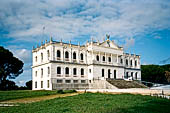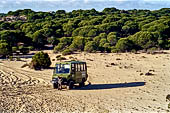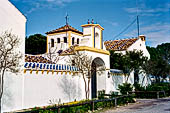| enter keyword to search: |
|
Images db
|
|
|
Articles db
|
|
|
|
|
| Photo Gallery Spanish Landscape |
|
|
|
The Guadalquivir , the 'big river' or Wada-I-Kebir of the Moors, flowing from the Sierra Morena through Córdoba and Seville, enters the Atlantic Ocean
forming a large delta. Gradually the original delta sunk behind the high sand dunes blown by the mighty Atlantic winds that during the centuries have created a natural barrier to the river and then forming the vast marshes of today. Known as
Las Marismas del Guadalquivir, before becoming the world wide known
Coto Doņana National Park, for centuries this area has been only a vacant spot on the map a vast inhospitable marsh land. As early as the thirteenth century, it was the favourite hunting reserve of Spanish kings. Later the dukes of Medina Sidonia made it their private coto. One of the duchesses Doná Ana built her hermitage here and as a result, the entire region came to be known as the 'forest of Doná Ana', or Doņana. The palace of Doņana remains as a testimony to this past.

|
Spain, Coto Doņana Natinal Park
|
In more recent years vast areas of the marshes were drained and converted to farmland, today the tract of marsh at the west of the river, protected by the National Park, are the only remained intact. The site is one of the largest and best-known wetlands in Europe, inscribed on UNESCO's World Heritage List. It contains a large stretch of undeveloped coastline, and protects one of the few mobile dune systems found on the Iberian peninsula.
Andalucia, Coto Doņana
|
 |
The park is notable for the great diversity, comprises three distinct kinds of ecosystem, the
marismas, the dunes and the matorral. The marismas, covering almost half the reserve area comprises a mosaic of microhabitats: marshlands, lagoons, pools, banks, streams, reedbeds and mudflats. The dune system consists of fixed and
shifting dunes, some of which move very rapidly. Scrub woodland and maquis vegetation has stabilized some dunes, in the
"corrales", damp hollows among the mobile dunes, there are lagoons, marshy areas and scattered pine woods. The heathland vegetation,
matorral, is typical Mediterranean thicket of narrow leaved cistus heather, mastic tree, rosemary, cistus scrub, red lavender, and are more Atlantic species such as the camarina. Sand vegetation includes plantations of cork oak alcornocales and wild olive trees acebuce.
Doņana is well known for the avifauna with large variety of species of birds, either
residents or winter visitors from north and central Europe or summer visitors from Africa, such as numerous types of geese and colourful colonies of flamingo. Delta waters which flood in winter and then drop in the spring leaving rich deposits of silt and raised sandbanks and islands, make the perfect conditions for large flocks of migrating birds of the west Europe to west Africa migration route. But it is particularly remarkable and most exiting in spring when hundreds of flocks of breeding birds are drown here, the marismas become alive with birds - some settling down to breed, others en route for more northern
climes and huge numbers of kites hang in the air. The cork oak forests in the marshes become then one of the largest heronries in the Mediterranean known as
"las pajareras" with an enormous quantity of spoonbills from North Africa nesting in the cork oaks.

|
Coto Doņana, El Rocio
|
On the edge of the Park the quiet town of El Rocio is perfect to spot flamingos and other birds on the shore of the nearby large lake. The town consists of streets of sand in a grid-based urban layout with one or two storey houses, rows and rows of
hermandades, and the Santuario of Nuestra Seņora de el Rocio, the biggest construction in the town.
At the feast of Pentecost however, the town comes alive with the arrival of the famous biggest
romeria, or pilgrimage, in Spain. Every year around one million people converge on the shrine of El Rocio, in a religious festival in which pilgrims make their way on horseback or in brightly decorated multi-coloured caravans that wind across the Andalusian countryside, to sing the praises of the Virgin, popularly known as the Blanca Paloma or White Dove who appeared in the 13th century and has become one of the most important objects of devotion in the whole of Andalucia.
| |
|
|
 |
|
|



